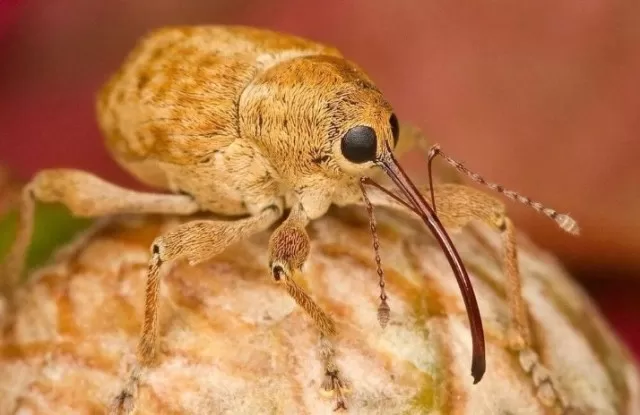Unwanted Pantry Guests: Identifying Food-Invading Pests. Pantry pests, those sneaky and unwelcome visitors, have a knack for turning our kitchen havens into a battleground.
From nibbling on our precious food supplies to leaving their tiny trails of mischief, these insects can be a real nuisance. Knowledge is the key to effective pest management, so let’s uncover the identity of eight of the most common culprits lurking in your pantry or cupboardsBy recognizing these common pantry pests, you can take swift action to protect your food supplies and maintain a pest-free kitchen environment.
Regularly inspecting and properly storing food items in airtight containers are essential steps to deter these pesky intruders. So, arm yourself with knowledge, and bid farewell to the unwelcome guests that threaten to disrupt your culinary haven.
The Pain of Pantry Pests: Safeguarding Your Kitchen and Taking Back Control

Discovering a box of cereal infested with tiny insects can turn any kitchen excursion into a distressing ordeal.
Pantry pests, relentless in their pursuit of sustenance, target a wide range of goods, from grains and dried fruit to pet food, causing frustration and unease for homeowners. To counter their persistent invasion, sealing all food items tightly might seem like an effective strategy.
However, even with the most immaculate airtight canisters, complacency is not an option. Unbeknownst to us, these sneaky invaders might hitch a ride into our pantries during our routine grocery trips.
Staying vigilant is crucial, as identifying these eight common pests is the first step towards eradicating them from our culinary spaces for good.
Maintaining an unyielding defense against pantry pests is essential to preserve the integrity of our stored food and maintain a clean and hygienic kitchen.
Adopting preventive measures, such as storing items in sealed containers, routinely inspecting the pantry, and cleaning up spills and crumbs promptly, can create an inhospitable environment for these unwelcome intruders.
Pantry pests come in various forms, including beetles, moths, weevils, and ants, each with its own distinct characteristics and preferences.
Identifying the specific pest wreaking havoc in your pantry can be challenging, especially if you lack expertise in entomology. In such cases, reaching out to reliable pest control companies like Orkin or Terminix can be a wise decision.
Their seasoned professionals possess the knowledge and experience needed to accurately identify the intruders and devise effective elimination strategies tailored to your unique situation.
Embracing a proactive approach to pest control not only safeguards our food but also protects our health and well-being.
The presence of pantry pests can lead to food contamination, causing potential health risks when ingested. Moreover, it can inflict financial losses as we discard tainted food and replace contaminated staples.
So, let us remain vigilant, arming ourselves with knowledge and prevention to thwart the relentless invasion of pantry pests.
By doing so, we can reclaim our kitchen’s tranquility and enjoy the peace of mind that comes with knowing our stored food is safe from these uninvited nuisances.
Indian Meal Moth: Conquering the Persistent Pantry Invader
The Indian meal moth (Plodia interpunctella) stands as one of the most formidable foes in the battle against pantry pests.
Unyielding and relentless, these small insects flaunt their distinctive two-tone wings, adorned with a light gray or cream hue in the front half and a captivating coppery color towards the rear. Although seemingly innocuous, they are anything but, causing distress and frustration for homeowners who unwittingly bring them home along with packages of flour, pasta, and other staples from the grocery store.
Their life cycle, while brief, is astonishingly prolific.
In a span of less than a week, a female Indian meal moth can lay an astonishing number of eggs—exceeding 300 in some cases. These minuscule eggs find their way onto or near dried food items, as well as any unsealed products lurking in the confines of your pantry or cupboard.
Once hatched, the larvae proceed to feast upon your precious stored goods, causing contamination and turning your kitchen into a battleground.
Eliminating Indian meal moths requires a multi-faceted approach, as they can be notoriously difficult to get rid of once they have established a foothold in your home.
Prevention remains the first line of defense, emphasizing the importance of inspecting all store-bought items for signs of infestation before introducing them into your pantry. Ensuring airtight storage for all susceptible food products can create an inhospitable environment for these pests and curb their ability to multiply.
Swift action is paramount when dealing with these determined invaders.
Identifying their presence early on and disposing of contaminated items promptly can help contain the infestation. Thoroughly cleaning the pantry and surrounding areas is crucial to eliminate any hidden eggs or larvae, further impeding their population growth.
Considering the resilience of Indian meal moths, seeking professional assistance from renowned pest control companies like Orkin or Terminix can be a prudent step.
Their expertise in dealing with such pests can offer targeted and effective solutions, tailored to your unique situation, aiding in the complete eradication of these bothersome intruders.
In conclusion, vigilance and knowledge are our best weapons in the war against Indian meal moths.
By understanding their behavior and employing preventive measures, we can defend our pantries from their invasion, ensuring the safety and sanctity of our stored food and reclaiming our kitchens from these persistent pantry pests.
Weevils: The Tiny Intruders Lurking in Your Pantry

Meet the weevil, a small but formidable adversary, measuring a mere 2 millimeters in size.
Don’t be deceived by their diminutive stature, for these insects possess remarkable reproductive capabilities. Adult female weevils can lay up to four eggs per day during their relatively long lifespan of four to five months, as reported by the National Pest Management Association.
With a preference for rice, oats, barley, and corn, these dark-colored pests stealthily infiltrate your pantry, making their way into your home from your yard or hitching a ride through infested foods from the grocery store.
Their discreet nature allows them to wreak havoc unnoticed until their presence becomes evident in your stored food items.
Discovering weevils in any packaged goods can be alarming, prompting a difficult decision: to salvage or to discard the product. While consuming a few weevils and their feces might not pose immediate health risks, the prospect remains far from pleasant, and it introduces unnecessary risks to the integrity of other items in your pantry.
Dealing with weevils requires a combination of vigilance and proactive measures.
Regularly inspecting store-bought items for signs of infestation before bringing them home can prevent their initial entry into your pantry. Additionally, storing susceptible food products in tightly sealed containers is crucial to impede their ability to spread and multiply.
If an infestation is detected, swift action becomes paramount.
Disposing of contaminated food items promptly can halt their progress and prevent further contamination. Thoroughly cleaning the pantry and surrounding areas helps eradicate any hidden eggs or larvae, further curbing their population growth.
Understanding the life cycle and behavior of weevils can aid in devising effective eradication strategies.
Seeking assistance from reputable pest control companies like Orkin or Terminix can provide professional expertise in dealing with these resilient pests, offering tailored solutions to eliminate them from your home effectively.
In conclusion, staying vigilant against weevils and adopting preventive measures can safeguard the contents of your pantry and protect you from the unpleasant surprise of discovering these tiny intruders in your food.
With diligence and knowledge, you can maintain a pest-free pantry and enjoy the assurance that your stored food remains safe and uncontaminated.
Cigarette Beetle: Beyond Tobacco, a Pantry Marauder
Despite their name suggesting a preference for tobacco, the cigarette beetle (Lasioderma serricorne) possesses a diverse appetite that extends to various pantry staples.
While they do indeed indulge in tobacco products, these resourceful beetles also gravitate toward cereals, nuts, and pet food, demonstrating their adaptability to a wide range of food sources. They even venture into the realm of dried herbs and spices, making paprika a potential target for their voracious appetites. Don’t underestimate their size either; measuring only about 1/8 inch in length, these light brown beetles exhibit a distinctive humpback shape, allowing them to navigate tight spaces with ease.
Cigarette beetles can gain entry into your home through several avenues, displaying their knack for infiltration.
Open windows, gaps under doorways, and cracks in your home’s foundation provide potential access points, enabling their incursions. However, their craftiness extends beyond exploiting structural vulnerabilities; they can also hitch a ride indoors by infiltrating infested products you bring home.
The resilience and adaptability of these pantry marauders make them challenging to eradicate.
Prevention is key in thwarting their invasion. Ensuring that all food items are securely stored in airtight containers can create an inhospitable environment for these beetles, reducing the likelihood of infestations.
Regularly inspecting store-bought items for signs of beetles or larvae before introducing them to your pantry can also help curb their spread.
When dealing with a cigarette beetle infestation, swift action is crucial.
Identifying and discarding contaminated items promptly can limit their impact and prevent further infestation. Comprehensive cleaning of the pantry and surrounding areas is essential to eliminate any lingering eggs or larvae, further hindering their population growth.
If the infestation proves persistent or extensive, seeking the expertise of reputable pest control companies like Orkin or Terminix becomes imperative.
Their professional knowledge and experience can aid in developing targeted strategies to eliminate these crafty beetles effectively.
In conclusion, vigilance and proactive measures are essential in safeguarding your pantry from the infiltration of cigarette beetles.
By understanding their behavior and preferences, you can fortify your home against their incursions and protect your stored food items from their voracious appetites. With diligence and preventative measures, you can maintain a beetle-free pantry, ensuring the safety and integrity of your household’s food supply.
Warehouse Beetle: Sneaky Pests in Your Pantry

Meet the warehouse beetle (Trogoderma variabile), a small and oval-shaped pest that poses a threat to your pantry goods.
With a color palette ranging from brown to black, these uninvited intruders take delight in packaged staples such as grains, cereals, and pet foods. However, their presence goes beyond mere consumption; they bring with them the menace of contamination, rendering infested products unsuitable for consumption.
If you spot these pests in your pantry, it’s best to act swiftly and dispose of any affected items.
The warehouse beetle employs cunning tactics to infiltrate your home, often hitching a ride within infested food products or taking advantage of any open doors or windows.
Their resourcefulness in finding entry points allows them to breach your home’s defenses, catching you unaware of their presence until it’s too late.
If you do encounter a warehouse beetle within your home, try not to panic.
Not every sighting implies a full-blown infestation. The National Pest Management Association clarifies that adult warehouse beetles possess adept flying skills, enabling them to move around with relative ease.
So, finding a single beetle does not necessarily signify a large-scale infestation. However, it serves as a timely warning to remain vigilant and take necessary precautions.
To safeguard your pantry from the menace of warehouse beetles, preventative measures are paramount.
Storing pantry items in tightly sealed containers can create a hostile environment, discouraging these pests from infesting your food supply. Regularly inspecting store-bought goods for signs of infestation before bringing them home can also prevent their initial entry.
Swift action is essential if you do discover an infestation.
Promptly discarding contaminated items and thoroughly cleaning the affected pantry area can contain the spread and mitigate potential damage.
If the situation becomes overwhelming, seeking the expertise of reputable pest control companies like Orkin or Terminix can offer tailored solutions to eliminate warehouse beetles effectively.
In conclusion, staying vigilant against warehouse beetles and adopting preventative measures is crucial in protecting your pantry from contamination and preserving your stored food’s integrity.
With knowledge and diligence, you can thwart the efforts of these sneaky pests, maintaining a safe and pest-free environment for your household’s food supply.
*The information is for reference only.